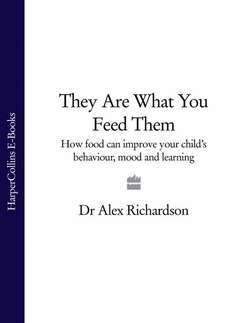Читать книгу They Are What You Feed Them: How Food Can Improve Your Child’s Behaviour, Mood and Learning - Dr Richardson Alex - Страница 64
Proteins
ОглавлениеProteins are the main building-blocks of living things, so a regular supply of protein is essential for brain and body growth and maintenance. The very structure of most of our tissues—like muscles, tendons or bones—depends on proteins. The enzymes that assist or enable almost all biochemical reactions are usually made of proteins; the receptors and other channels for signalling within and between cells are mostly made of proteins. Many of the messenger-molecules that carry information via those channels are also proteins, or fragments of proteins called ‘peptides’.
When we eat and digest proteins, they’re broken down into their component amino acids. There are 20 types of amino acids we use. When we need a new protein, it’s assembled from specific amino acids arranged in a particular sequence (a sequence dictated by your genes). The resulting chain of amino acids then folds up in a special way to achieve the proper structure of that protein. Peptides, which are used as important signalling molecules in many brain and body systems, are simply shorter chains of amino acids.
There are eight ‘essential amino acids’ that we can’t make for ourselves, so they must come from our diets. You can make the other 12 amino acids your body needs.
The eight essential amino acids go by the names of: isoleucine, leucine, lysine, methionine, phenylalanine, threonine, tryptophan and valine. Some lists include a ninth: arginine.
Don’t worry about learning the names—just make sure your child eats a range of protein-rich foods.
We need a regular intake of good-quality protein to build, repair and run many body systems, so make sure your child gets enough. Don’t overdo it, though—because too much protein can affect your kidneys—but most people don’t eat too much protein unless they’re on some diet that leaves out much of another food group (like carbohydrates), and that’s not recommended. Your child needs to eat only a handful of protein (a quarter or less of the plateful) at any meal, but just vary the type. This could include lean meat, fish, eggs, cheese, nuts, or beans and pulses.2
